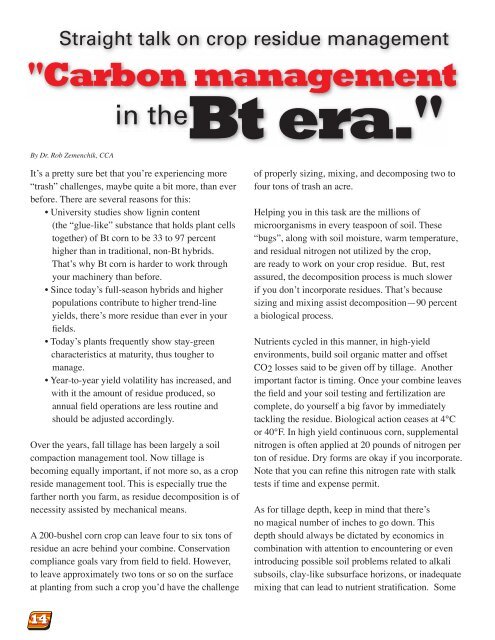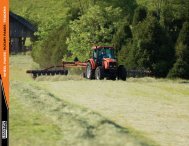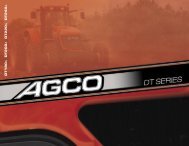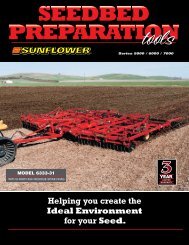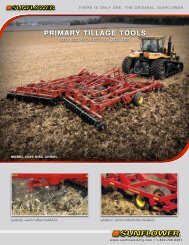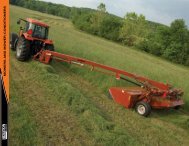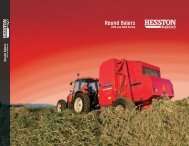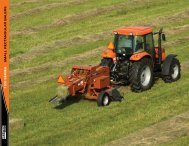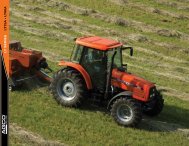Create successful ePaper yourself
Turn your PDF publications into a flip-book with our unique Google optimized e-Paper software.
Straight talk on crop residue management<br />
"Carbon management<br />
in the<br />
Bt era."<br />
By Dr. Rob Zemenchik, CCA<br />
It’s a pretty sure bet that you’re experiencing more<br />
“trash” challenges, maybe quite a bit more, than ever<br />
before. There are several reasons for this:<br />
• University studies show lignin content<br />
(the “glue-like” substance that holds plant cells<br />
together) of Bt corn to be 33 to 97 percent<br />
higher than in traditional, non-Bt hybrids.<br />
That’s why Bt corn is harder to work through<br />
your machinery than before.<br />
• Since today’s full-season hybrids and higher<br />
populations contribute to higher trend-line<br />
yields, there’s more residue than ever in your<br />
fields.<br />
• Today’s plants frequently show stay-green<br />
characteristics at maturity, thus tougher to<br />
manage.<br />
• Year-to-year yield volatility has increased, and<br />
with it the amount of residue produced, so<br />
annual field operations are less routine and<br />
should be adjusted accordingly.<br />
Over the years, fall <strong>tillage</strong> has been largely a soil<br />
compaction management tool. Now <strong>tillage</strong> is<br />
becoming equally important, if not more so, as a crop<br />
reside management tool. This is especially true the<br />
farther north you farm, as residue decomposition is of<br />
necessity assisted by mechanical means.<br />
A 200-bushel corn crop can leave four to six tons of<br />
residue an acre behind your combine. Conservation<br />
compliance goals vary from field to field. However,<br />
to leave approximately two tons or so on the surface<br />
at planting from such a crop you’d have the challenge<br />
of properly sizing, mixing, and decomposing two to<br />
four tons of trash an acre.<br />
Helping you in this task are the millions of<br />
microorganisms in every teaspoon of soil. These<br />
“bugs”, along with soil moisture, warm temperature,<br />
and residual nitrogen not utilized by the crop,<br />
are ready to work on your crop residue. But, rest<br />
assured, the decomposition process is much slower<br />
if you don’t incorporate residues. That’s because<br />
sizing and mixing assist decomposition—90 percent<br />
a biological process.<br />
Nutrients cycled in this manner, in high-yield<br />
environments, build soil organic matter and offset<br />
CO2 losses said to be given off by <strong>tillage</strong>. Another<br />
important factor is timing. Once your combine leaves<br />
the field and your soil testing and fertilization are<br />
complete, do yourself a big favor by immediately<br />
tackling the residue. Biological action ceases at 4°C<br />
or 40°F. In high yield continuous corn, supplemental<br />
nitrogen is often applied at 20 pounds of nitrogen per<br />
ton of residue. Dry forms are okay if you incorporate.<br />
Note that you can refine this nitrogen rate with stalk<br />
tests if time and expense permit.<br />
As for <strong>tillage</strong> depth, keep in mind that there’s<br />
no magical number of inches to go down. This<br />
depth should always be dictated by economics in<br />
combination with attention to encountering or even<br />
introducing possible soil problems related to alkali<br />
subsoils, clay-like subsurface horizons, or inadequate<br />
mixing that can lead to nutrient stratification. Some<br />
14


